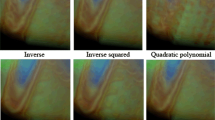Abstract
This paper presents an approach for surface rendering in 3D rectilinear datafield. The approach will first detect the border of the given object in the field by underlying function fitting and the second gradient derivative calculating. On marking the border cells, they will be rendered in polygons to fit the surface of the object. The implementation, as well as some experiments, is given in the paper.
Similar content being viewed by others
References
Drebin R A, Carpenter Let al.. Volume rendering.ACM Computer Graphics, 1988, 22(4): 65–74.
Ney D R, Fishman, E Ket al.. Volumetric rendering of computed tomography data: Principles and techniques.IEEE Computer Graphics and Applications, 1990, 10(2): 24–32.
Lorensen W E, Cline H E Marching cubes: A high resolution 3D surface construction algorithm.ACM Computer Graphics, 1987, 21(4): 163–169.
Haralick R M. Digital step edges from zero crossing of second directional derivatives.IEEE Trans., PAMI, 1984, 6(1): 58–68.
Li Bin. Research and implementation of techniques for 3D scalar data field visualization. Doctoral Dissertation, Beijing: Institute of Computing Technology, Chinese Academy of Sciences 1996.
Ranjan V, Fournier A. Volume models for volumetric data.IEEE Computer, 1994, 43(7): 28–36.
Cohen D, Kaufman A. Scan conversion algorithms for linear and quadratic objects. In Volume Visualization, Kaufman (ed.), IEEE Computer Society Press, 1991, pp.280–299.
Author information
Authors and Affiliations
Additional information
This work is supported by the National Natural Science Foundation of China, the National ‘863’ High-Tech Program, and the President Foundation of Institute of Computing Technology, Chinese Academy of Sciences.
Li Bin is an Associate Professor in Institute of Computing Technology (ICT), Chinese Academy of Sciences (CAS). His research interests focus on compuer graphics and scientific visualization. He received his B.S. and M.S. degrees in computer architecture from Nanjing Univerisity in 1988 and 1991, and his Ph.D degree in ICT, CAS in 1996, respectively.
Liang Xundong is a Post Doctor in Computer Institute, Beijing University. His research interests focus on computer graphics, virtual reality and scientific visualization. He received his B.S. and M.S. degrees in computer engineering from Shandong Polytechnique University in 1982 and 1989, and his Ph.D. degree in ICT, CAS in 1996, respectively.
Liu Shenquan is a Professor in ICT, CAS. His research interests focus on computer graphics, CAD, scientific visualization and computer animation. He received his Ph.D. degree on physics-mathemetical science in Moscow in 1962.
Rights and permissions
About this article
Cite this article
Li, B., Liang, X. & Liu, S. A surface rendering approach in 3D rectilinear datafield. J. of Comput. Sci. & Technol. 13, 220–227 (1998). https://doi.org/10.1007/BF02943190
Received:
Issue Date:
DOI: https://doi.org/10.1007/BF02943190




